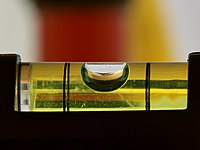
Photo from wikipedia
Abstract Shale is affected by high temperature and loads in deep mining, shale gas extraction, underground disposal of nuclear waste, and other shale projects. This paper aims to investigate the… Click to show full abstract
Abstract Shale is affected by high temperature and loads in deep mining, shale gas extraction, underground disposal of nuclear waste, and other shale projects. This paper aims to investigate the effects of thermal treatment on the physical and mechanical properties of shale. The uniaxial compression test and acoustic emission (AE) monitoring were conducted on shale specimens with different bedding plane inclinations (0°, 30°, 45°, 60°, and 90°) after thermal treatment of different temperatures. The results show that the P-wave velocity decreases with the increase in bedding plane inclination at each thermal treatment temperature showing anisotropy. A thermal explosion occurs when the specimen reaches the macroscopic thermal damage threshold temperature, and the threshold temperature and intensity of the thermal explosion are linked to the bedding plane inclination. The peak stress of specimens with the bedding plane inclinations of 0°, 45°, and 90° increases with the rise in thermal treatment temperature. After thermal treatment, the relationship curve between the cumulative AE counts of specimens with different bedding plane inclinations and time presents a step-jump trend. The thermal treatment has no significant effect on the failure modes of specimens with bedding plane inclinations of 30°, 60°, and 90°, while specimens with bedding plane inclinations of 0° and 45° begin to splitting failure with a rise in the thermal treatment temperature. The rockburst failure occurs in the shale specimens, and the main phenomena are spalling, particle ejection, and block collapse. The thermal treatment has a significant influence on the rockburst intensity of specimens with different bedding plane inclinations.
Journal Title: Journal of Natural Gas Science and Engineering
Year Published: 2020
Link to full text (if available)
Share on Social Media: Sign Up to like & get
recommendations!